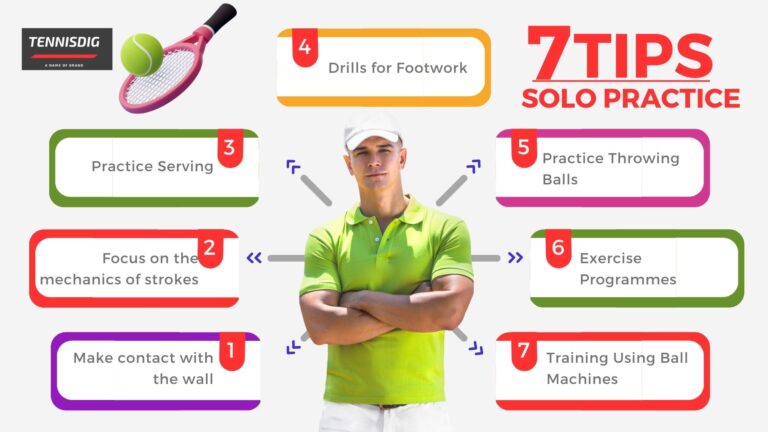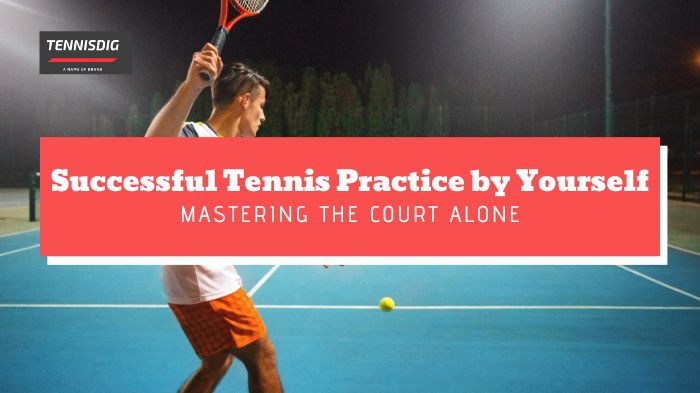Tennis is frequently regarded as a social activity; however, practicing with a partner is only sometimes necessary. There are several drills and strategies to improve your game, whether you’re a lone enthusiast trying to polish your talents or just looking to work out on the court by yourself. In this article, we’ll look at how to practice tennis alone, covering practical solo activities that range from physical training to stroke mechanics.
Which tennis drills work best for you when you train alone?
While it might not have the same lighthearted banter and friendly rivalry as a doubles match, solo tennis practice offers a concentrated opportunity to work on certain skills. You can include the following productive single-tennis drills in your training regimen:

1. Make contact with the wall
Hitting against a wall is a traditional, flexible solo drill that helps you hone your groundstrokes, volleys, and even serves. Ensure you have room to move about and respond to the rebounding ball by maintaining a comfortable distance from the wall. This is a great drill to improve footwork, consistency, and precision.
2. Focus on the mechanics of strokes
The best time to improve your stroke mechanics is during solo practice. Concentrate on dissecting each stroke individually to guarantee the correct technique. Slow-motion swings can be used to assess your form and make the necessary corrections. This systematic approach may result in more potent and precise shots during games.
3. Practice Serving
In tennis, the serve is a critical talent that can only be honed via practice. Set up targets on the other half of the court and practice hitting them often. To create a versatile and unpredictable serving game, try various serves, such as kick, slice, and flat.
4. Drills for Footwork
Drills focusing on solo footwork can greatly improve your court coverage and quickness. Cones or markers can be arranged in different configurations on the court; then, practice making swift and forceful movements between them. Include diagonal shuffles, forward and backward sprints, and lateral motions to replicate the dynamic footwork needed in a game.
5. Practice Throwing Balls
Practice throwing the ball is essential for players who want to improve their serves and overhead strokes. Practice hitting the ball with your racquet properly by tossing it into the air. This exercise improves timing, hand-eye coordination, and the capacity to make firm ball contact.
6. Exercise Programmes
Tennis requires strength and physical stamina. To incorporate fitness training into your schedule, use solitary practice sessions. Your total level of fitness can be raised by doing agility drills, bodyweight workouts like lunges and squats, and running laps around the court. This will increase your performance on the court.
7. Training Using Ball Machines
Purchasing a tennis ball machine can help you advance your practice. Ball machines offer a dynamic and demanding training experience by simulating different shots, speeds, and trajectories. Change the parameters to isolate particular strokes or generate accurate match situations.
My Top Picks for Solo Tennis Practice Exercises
Drill 1: Challenge of the Wall Rally
Try to strike the ball against the wall a set amount of times by continually striking it against it. With the help of this practice, you may improve your control, consistency, and ability to strike the stroke in a steady rhythm.
Drill 2: Practice Using the Target
Use cones or markers to set up targets on the court. Practice continuously striking the ball into these targets while positioned in various ways around the court. Your precision and accuracy will improve with this drill.
Drill 3: Run and Serve
Mix physical training with serving experience. Serve the ball, run to a specific court area, and return to serve. This workout will improve your serve and ability to recover fast between points.
Last Words
Practice tennis alone is a thorough method for improving your game and honing your skills. It goes beyond simply hitting balls against a wall. To create a well-rounded training regimen, include drills that target footwork, fitness, shot types, and stroke mechanics.
When practicing alone, consistency is essential. Make time for it regularly, stay concentrated, and monitor your improvement. Tennis alone may be a fun and productive approach to improving your game, regardless of whether you play for fun or want to compete at a higher level. Accept the quiet of the court, see it as a chance for personal growth, and see your abilities soar with consistent solitary tennis practice.

